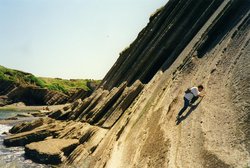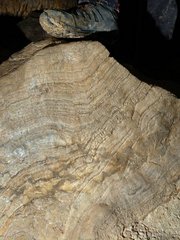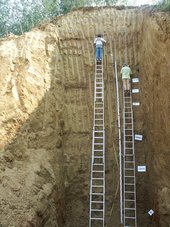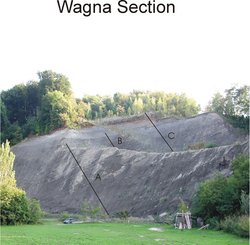Speleothems of the Conturines Cave: A potentially unique palaeo environment archive in the Dolomites (2011-2013)
In the past decade, the research on speleothems has become a much observed branch of palaeo climate research worldwide. New methods are being developed to elicit information from these stony witnesses of times long past. Information which can tell us much about the environmental conditions at the time of the formation of these sinters. The present research project wants to turn over a new leaf in the research of this singular cave. It is our aim to determine at which point in recent geological history the sinters of Conturines Cave were formed and what records of the then climate of the Dolomites are stored in them.
Conceived as a pilot study, our aim is, using modern methods, to study a possibly unique archive of the environmental and climatic development in the Dolomites with a powerful international team of experts, coordinated by the University of Innsbruck. Even though it is not used as a standard, the palaeomagnetic signal, which is contained in the form of ferromagnetic phases in traces in the calcite of speleothems, can contain a robust recording of the orientation of the geomagnetic field at the time of the calcite’s formation. An inverse direction of the dipole field serves as a reliable sign that the sampled speleothem layer must be older than 780 ka (the Brunhes/Matuyama threshold).
Within this explorative study, we are therefore planning to analyse the magnetic properties of a series of samples from orientated drill cores. Accompanying magneto-mineralogical analyses are to identify the magnetic carrier minerals. The Montanuniversität Leoben (R. Scholger) will be responsible for this part of the project. In an earlier internal collaboration, we analysed a series of speleothem samples from Alpine caves in Austria. We were able to measure magnetic paramenters (including the palaeo intensity) even in ultrapure (translucent) calcite samples with a cryogenic magnetometer.
Executed with grants from the Autonomous Province Bozen/Southern Tyrol (Department 40, Office 40.3, Office for the Funding of Higher Education, University and Research)
Project manager: Christoph Spötl (Univ. Innsbruck, Quaternary Research Group)
The LOESS-sequence Wels/Aschet: A reference profile for the Middle and Late Pleistocene in the northern Alpine foothills
By means of excavation access was gained to a profile with a thickness of 12 m. Five strongly developed palaeo soils or pedocomplexes alternate with interposing loess loam layers. The excursions observed in the Aschet profile are assigned to the time interval of 570.000 until 110.000. The Brunhes/Matuyama threshold (776.000) was not reached. The palaeomagnetic examinations were performed on initiative of Prof. Dirk van Husen with financial support from the Commission of Quaternary Research of the Austrian Academy of Sciences.
Cooperation partners:
- Birgit Terhorst (Univ. Würzburg)
- Jürgen Reitner (Geological Survey of Austria, Vienna)
- Dirk van Husen (TU Vienna, Prof. i.R)
Paleomagnetic reconstruction of geodynamic events and climate changes in the Eastern Alpine Miocene (FWF-Project P13738)
The influence of geodynamic processes on the ecosystems and environmental conditions in the Eastern Alps was analysed within the framework of a multi-disciplinary research project bundle together with partners from other Austrian university departments as well as the Museum of Natural History of Vienna and the Geological Survey of Austria. Extensive palaeomagnetic research of the Molasse Zone, the Vienna Basin, the Styrian Basin and the Lavant Valley yielded new insights into the geological history of development of the Eastern Alpine region during the Miocene.
At several of the research sites the new results allowed a more precise identification of the geological ages of the basin sediments. The magnetostratigraphic results supported the biostratigraphic datings especially in the correlation of results from different depositional environments.
Publications
Scholger, R. & Terhorst, B. (2013): Magnetic excursions recorded in the Middle to Upper Pleistocene loess/palaeosol sequence Wels-Aschet (Austria).
E&G Quaternary Science Journal, 62, 1: 14-21.
Gross, M., Piller, W.E., Scholger, R., Gitter, F. (2011): Biotic and abiotic response to palaeoenvironmental changes at Lake Pannons' western margin (Central Europe, Late Miocene).
Palaeogeography, Palaeoclimatology, Palaeoecology, 312, 1–2: 181-193.
Scholger, R. & Terhorst, B. (2011): Paläomagnetische Untersuchungen der pleistozänen Löss-Paläobodensequenz im Profil Wels-Aschet. In: Van Husen, D. & Reitner J. (eds.): Die Löss-Sequenz Wels/Aschet.- Ein Referenzprofil für das Mittel- und Jungpleistozän im nördlichen Alpenvorland (MIS 16 bis MIS2).
Mitt. Komm. Quartärforsch. Österr. Akad. Wiss., 19: 47-63, Vienna.
Grunert, P., Soliman, A., Coric, S., Scholger, R., Harzhauser, M. & Piller, W.E. (2010): Stratigraphic re-evaluation of the stratotype for the regional Ottnangian stage (Central Paratethys, middle Burdigalian).
Newsletters on Stratigraphy, 44, 1, 1-16.
Brandner, R., Horacek, M., Keim, L & Scholger, R. (2009): The Pufels/Bulla road section: deciphering environmental changes across the Permian-Triassic boundary to the Olenekian by integrated litho-, magneto- and isotope stratigraphy. A field trip guide.
Geo. Alp, 6: 116-132, Innsbruck.
Hohenegger, J., Rögl, F., Coric, S., Pervesler, P., Lirer, F., Roetzel, R., Scholger, R. & Stingl, K. (2009): The Styrian Basin: a key to the Middle Miocenne (Badenian/Langhian) Central Paratethys transgressions.
AJES, 102: 102-132, Vienna.
Wagreich, M., Pervesler, P., Khatun, M., Wimmer-Frey, I. & Scholger, R. (2008): Probing the underground at the Badenian type locality: geology and sedimentology of the Baden-Sooss section (Middle Miocene, Vienna Basin, Austria).
Geologica Carpathica, 59, 5: 375-394, Bratislava.
Coric, S., Harzhauser, M., Hohenegger, J., Mandic, O., Pervesler, P., Roetzel, R., Rögl, F., Scholger, R., Spezzaferri, S., Stingl, K., Svabenicka, L., Zuschin, M. (2004): Stratigraphy and correlation of the Grund Formation in the Molasse Basin, northeastern Austria (Middle Miocene, Lower Badenian).
Geologica Carpathica, 55, 2: 207-215, Bratislava.
Scholger, R. & Stingl, K. (2004): New paleomagnetic results from the Middle Miocene (Karpatian and Badenian) in Northern Austria.
Geologica Carpathica, 55, 2: 199-206, Bratislava.
Summesberger, H., Wagreich, M., Tröger, K.-A. & Scholger, R. (2002): The Upper Cretaceous of Piesting (Austria): Integrated stratigraphy of the Piesting Formation (Gosau Group). In: Wagreich, M (Ed.): Aspects of Cretaceous Stratigraphy and Palaeobiogeography. Österr. Akad. Wiss.
Schriftenr. Erdwiss. Komm, 15: 373-399, Austrian Academy of Sciences Press, Vienna.
Scholger, R. (2000): Paläomagnetische Untersuchungen im Riß/Eem-Profil Nieselach (Kärnten): Altersstellung, Paläoklima und Sedimentationsbedingungen. in: Van Husen, D. (Ed.): Klimaentwicklung im Riss/Würm Interglacial (Eem) und Frühwürm in den Ostalpen.
Mitt. Komm. Quartärforsch. 12: 141-154, Österr. Akademie der Wissenschaften, Wien.
Scholger, R., Mauritsch, H.J. & Brandner, R. (2000): Permian-Triassic boundary magnetostratigraphy from the Southern Alps (Italy).
Earth Planet. Sci. Lett., 176/ 3-4: 495-508, Elsevier.
Franzen, J.L., Gliozzi, E., Jellinek, T., Scholger, R. & Weidenfeller, M. (2000): Die spätaltpleistozäne Fossillagerstätte Dorn-Dürckheim 3 und ihre Bedeutung für die Rekonstruktion der Entwicklung des rheinischen Flußsystems. (Kap. 4: Paläomagnetik).
Senckenbergiana lethaea, 80 (1): 305-353, Frankfurt.
Latal, C., Scholger, R. & Preisinger, A. (2000): Paleomagnetic investigations imply rotations within the Cretaceous-Tertiary transition section at Cerbara (Italy).
Phys. Chem. Earth (A), 25, 5: 499-503, Elsevier.
Scholger, R. (1998): Magnetostratigraphy and palaeomagnetic analysis from the Early Miocene (Karpatian) deposits Teiritzberg and Obergänserndorf (Korneuburg Basin, Lower Austria).
Beitr. Paläont., 23: 25-26, Wien.
Scholger, R. & Mauritsch, H.J. (1998): Paläomagnetische Untersuchungen im steirischen Tertiärbecken am Beispiel des Tagebaues Oberdorf.
Mitt. Ref. Geol. und Paläont. Landesmuseum Joanneum, SH2: 315-324, Graz.
Mauritsch, H.J. & Scholger, R. (1998): Palaeomagnetism and Magnetostratigraphy from the Miocene lignite Opencast Mine Oberdorf (N Voitsberg, Styria, Austria).
Jb. Geol. B.- A., 140, 4: 429-432, Wien.
Steininger,F. Daxner-Höck, G., Haas, M., Kovar-Eder, J., Mauritsch, H.J., Meller, B. & Scholger,R. (1998): Stratigraphy of the Basin-Fill in the Early Miocene Lignigte Opencast Mine Oberdorf (N Voitsberg, Styria, Austria).
Jb. Geol.B.-A., 140, 4: 491-496, Wien.
Preisinger, A., Aslanian, S., Stoykova, K., Grass, F., Mauritsch, H.J. and Scholger, R. (1993): Cretaceous/Tertiary boundary sections on the coast of the Black Sea near Bjala (Bulgaria).
Palaeogeography, Palaeoclimatology, Palaeoecology, 104: 219-228, Elsevier, Amsterdam.
Holser, W. T., Schönlaub, H.-P., Attrep, M. J., Böckelmann, K., Klein, P., Magaritz, M., Orth, C. J., Fenninger, A., Jenny, C., Kralik, M., Mauritsch, H., Pak, E., Schramm, J.-M., Stattegger, K., Schmöller, R. (1989): A unique geochemical record at the Permian/Triassic boundary.
Nature, 337, S. 39 – 44.
Preisinger, A., Zobetz, E., Gratz, A. J., Lahodynsky, R., Becke, M., Mauritsch, H., Eder, G., Grass, F., Rögl, F., Stradner, H., Surenian, R. (1986): The Cretaceous/Tertiary boundary in the Gosau Basin, Austria.
Nature, 322, S. 794 – 799.



